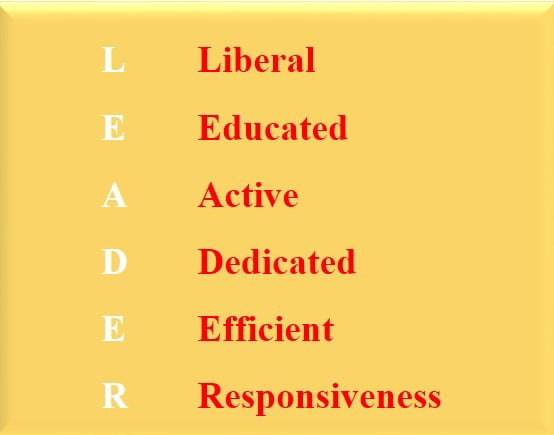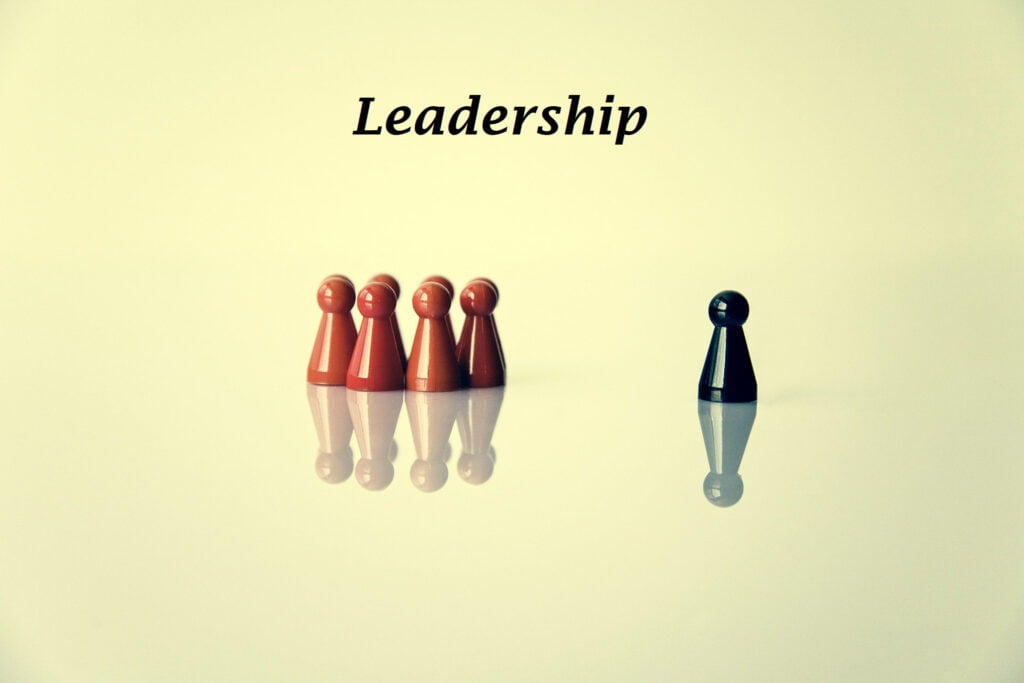What is the meaning of leadership? , there are many definitions for leadership. It is an art of influence on people to achieve a common goal. Alternatively, leadership can be defined as a process of inspiring others. This chapter briefly describes some essential areas about leadership, including the definition of leadership, qualities of a good leader, different leadership styles, and the difference between leadership and management.
Definition of leadership
Leadership can be defined as the ability to influence individuals or groups to achieve specific goals and objectives. It is a process that two or more people interconnect with each other, and one party influences others’ attitudes, behavior, and perceptions.
Who is a leader?
A leader is a person who can influence people or groups to achieve desired goals and objectives. Some Examples of leaders are political leaders, corporate leaders, religious leaders, and military leaders.
When considering the types of leaders, there are two types of leaders: formal and informal.
A formal leader is a person who is given authority by the entity to influence other organization members to reach the entity’s goals and objectives.
An informal leader means a person who has no formal authority to influence others but can influence others because of his/her talents or skills.

Qualities of a good leader
Being a good leader is not easy; it is tough to change other’s attitudes, behaviors, and perceptions to achieve goals. Therefore a leader must have some best qualities to be a good leader in the organization/group. A good leader’s qualities are vision, focus, strategic planning, cooperation, humility, integrity, and courage.
Vision
A good leader has a vision. It means they have a clear idea about what they will do in the future to achieve desired goals and objectives. The leaders who have a vision are excellent at strategic planning.
Focus
Great leaders focus on their strengths in other organization members and focus on the company’s strengths. In addition to that, they always focus on the needs of the organization and the organizational situation.
Strategic planning
strategic planning
Strategic planning is vital to clarify about organization’s current situation and where the organization is going. Strategic planning is one of the more critical leadership strengths. Good leaders are excellent at strategic planning. They can look ahead to forecast where the organization and the markets are going.
Cooperation
Cooperation is a good reason for the success or failure of many organizations. When there is good cooperation in the business, the employees will be more productive, and they will do their duties & responsibilities quickly and efficiently. Therefore cooperation is essential thing for the smooth functioning of the organization.
A good leader must have this ability to enhance the cooperation of other members of the organization. This will help to accomplish their goals smoothly.
Humility
Humility can be defined as appreciating others’ contributions & strengths, self-awareness, and openness to new ideas. Humility is not a weakness. It is the self-awareness and self-confidence to identify other’s values. Humble leaders help their members to enhance personal development and motivate the culture of responsiveness, recognition, and trust, essentials for success.
Integrity
Integrity means being trustworthy, honest, and reliable. It provides benefits to leaders and the organization as well. Integrity is a necessary term when doing strategic planning. The core of integrity can be identified as truthfulness.
Courage
Another essential quality of a good leader is courage. A good leader must have the courage to identify problematic situations while achieving goals and objectives because a leader has the responsibility for the results of decisions he made.
Leadership styles in management
Different leadership styles can be seen in management. According to Lewin’s leadership styles, there are three leadership styles: autocratic, participative, and Laissez-faire leadership style. Each of these leadership styles has different characteristics and different advantages and disadvantages.
Autocratic leadership
Autocratic leadership, alternatively known as authoritarian leadership, is a style that one person controls overall decision-making but takes little contribution from other group members. This autocratic leader used to make decisions based on their judgments & ideas and infrequently accept other ideas from the group members.
Characteristics of autocratic leadership style
- Most of the decisions are based on leader’s choices and judgments
- Allows little or no contribution from group members for decision making
- Decreases creativity and creative thinking of group members
- Clearly outlined rules and regulations
- Creates a highly structured working environment
- The leader provides instructions, methods, and processes for working.
When considering this autocratic leadership style, this also has some advantages and disadvantages like other styles. Furthermore, the fact is, the usefulness of this leadership style depends on the situation.
Advantages of autocratic leadership
- This autocratic style is beneficial when an organization or group needs some solutions immediately. Because of this style, the organization will able to make decisions quickly.
- If the leader is experienced and knowledgeable, this autocratic style is appropriate for fast and effective decision-making.
- When there is a lack of leadership in the group, the autocratic style may provide directions for the group members—for instance, students groups or co-workers groups.
- Suitable for stressful situations like military conflicts, construction activities, or other emergencies.
- Enhances the overall communication in the organization
- Give outlines, procedures, directions, and methods for the new members as well as inexperienced members.
Disadvantages
- This autocratic style does not consider new ideas or concepts of group members. It may be harmful to organizational success.
- Lack of creativity
- It is harmful to the morale of group members
- Lack of flexibility in the working environment
- Unable to make better decisions.
Democratic Leadership
Democratic leadership style, alternatively known as participative leadership, refers to a style that guides group members and contributes to decision-making. Therefore this democratic leadership style can be identified as the most effective style. Democratic leadership can increase productivity in the organization. Moreover, it enhances group member’s morale.
The following characteristics can be seen in this democratic style.
Characteristics of democratic leadership style
- Group members can engage with decision-making by sharing new ideas and opinions.
- Discuss with teams before taking actions
- Group members feel more engaged with decision making
- Creativity increases
- Inspiring trust and respect of others
Some values can be seen in this democratic style, such as trustworthiness, honesty, courage, intelligence, creativity, fairness, and competence. Based on these values, the organization/group will make better decisions and accomplish desired goals and objectives.
The pros and cons of democratic leadership are as follows.
Pros
- Generate new ideas and group members
- Productivity increases
- Powerful team relationships
- Improve job satisfaction
- A clear vision for the success
- Enhances team knowledge
Cons
- Productivity may reduce due to negative emotions
- It may take a long time to make decisions
- Measuring the results and responses may be difficult
- This democratic style is not a suitable style for everyone
- Most of the time, no one takes responsibility for failures.
Laissez-faire leadership
In a laissez-faire leadership style, the leader trusts their group members and lets them be involved in decision-making. Therefore the group members make decisions using resources, creativity, and experience to accomplish what they need. However, they are not provided any instruction or guidance by the leader. In this laissez-faire style, the subordinates or group members have the real lead in decision-making.
Characteristics of Laissez-faire leadership
- Group members/employees are allowed to make decisions
- Use many resources and tools
- Leaders take charge when there is a necessity
- Lack of guidance and instructions from leaders
- Lower productivity
- Helpful for understanding own strengths and weaknesses.
Advantages
- Improves personal growth
- Members can enhance their creativity and innovation
- Group members/ employees can make decisions quickly
- Relaxed working environment
- Highly motivated group members
Disadvantages
- It mainly depends on group members.
- There may be poor job performance due to a lack of knowledge or experience.
- Lower productivity
- Lack of accountability
- Poor involvement of leaders
- Group members who are new to the organization will face some difficulties.
- Unable to work well together in the workplace.
In addition to the above three leadership styles, there is also other leadership styles: transformational, transactional, and situational leadership.
Transformational leadership
Transformational leadership refers to a style that inspires and encourages team members/employees to accomplish goals and objectives. This transformational style involves the organizational process and helps their team member’s personal growth. Usually, transformational leaders are passionate, enthusiastic, energic, and emotionally intelligent. The group members are allowed to make decisions and find new solutions for the problems. The team members in the leadership track will also prepare themselves through training and mentoring to become transformational leaders.
Characteristics of transformational leadership
- Help to Improve the morale and personal development of group members.
- Builds organizational culture
- Provides training and mentoring
- Allow employees/ group members to involve with decision making
Advantages
- Reduces turnover costs
- Excellent in communication
- Employee motivation increases
- The productivity in the organization increases
- It builds team relationships among group members
Disadvantages
- Focus too much on a bigger picture
- It may lead to employee burnout
- need to maintain a continual communication
- It may be disruptive and risky
- Leaders may lose power if the employees disagree with the vision
Transactional leadership
Transactional leadership, alternatively known as managerial leadership, refers to a leadership type that focused on supervision, outcomes, organizational structure, and organizational performance. Well-defined roles can be seen in this transactional style, and the team members/ employees exactly know what they need to do and what they will be provided in exchange. Transactional leaders have the authority and clearly defined responsibilities to manage individual performance as well as organizational performance.
Characteristics of transactional leadership
- Transactional relationship between the team members and leader
- The processes are well structured and resistant to change
- Employees are not allowed to think or act creatively
- Clearly defined goals, objectives, tasks, and responsibilities
- The leader is used to only react to problems that happen but does not take actions to avoid problems
- Mainly focus on the organizational hierarchy, organizational structure, and organizational culture.
Advantages
- Motivate group members/employees to increase productivity
- Create achievable goals for team members at all levels
- Easy to recognize the chain of command
- Leaders focus on product improvements as well as cost-saving methods
- No need for emotional intelligence, special training, or specific personality traits for the leadership.
Disadvantages
- Lack of creative thinking due to structured rules and regulations
- Zero value for the emotions and only consider about production process essentials.
- Increases dissatisfaction and unhappiness of team members
- Unbendable rules and organizations
- Leaders do not focus on building team relationships with the members.
- Only focuses on short-term goals.
Situational leadership
Situational leadership refers to a leadership style which is the leader needs to adjust his style. It means the leader modifies or changes the style according to the situation’s requirements to adapt leadership style to the situation. In this case, the leaders must consider some terms, including the type of the task, the nature of the task, level of authority, level of maturity, and other factors related to the task.
Characteristics of situational leadership
- Flexibility
- The leadership style changes according to the situation
- Gives directions to subordinates
- Provide detailed instructions and focus on team members
- Delegating
- Excellent in communication
- A clear vision
Advantages
- Leaders can manage every situation with the flexibility
- a relaxed working environment for the employees/team members
- Usually, it is a simple leadership style
- Easy to identify employee skills as well as employee requirements
- Improve the effectiveness in the organization
- Closer attention for employees/team members
Disadvantages
- Mainly considers short-term needs instead of long-term needs in the organization.
- Sometimes leaders are unable to get enough information
- There may be confusion within the organization
- Some leaders are unable to handle some tasks due to a lack of skills and experience.
- It is difficult for grading employees/ team members
Conclusion
- The ability of influence on others to accomplish specific goals and objectives can be referred to as leadership. Itt is a process that two or more people interconnect with each other, and one party influences the other’s attitudes, behavior, and perceptions.
- A leader is a person who can influence other’s attitudes, behavior, and perceptions.
- A leader must have some best qualities to be a good leader in the organization/group. A good leader’s qualities include vision, focus, strategic planning, cooperation, humility, integrity, and courage.
- Different types of leadership styles can be seen in management. According to Lewin’s leadership styles, there are mainly three styles, including autocratic, participative, and Laissez-faire leadership style.
- Autocratic leaders are used to making decisions based on their judgments & ideas and infrequently accept other group members’ ideas.
- Democratic style refers to a leadership style that gives guidance to group members and gets their contribution for the decision making.
- In a laissez-faire style, the group members make decisions using resources, creativity, and experience to accomplish what they need. Nevertheless, they are not provided any instruction or guidance by the leader.
- Transformational leadership involves the organizational process as well as helps their team member’s personal growth. Usually, transformational leaders are passionate, enthusiastic, energic, and emotionally intelligent.
- Transactional leadership refers to a style focused on supervision, outcomes, organizational structure, and organizational performance.
- In Situational leadership, the leader modifies or changes the style according to the situation’s requirements to adapt the leadership style to the situation.





